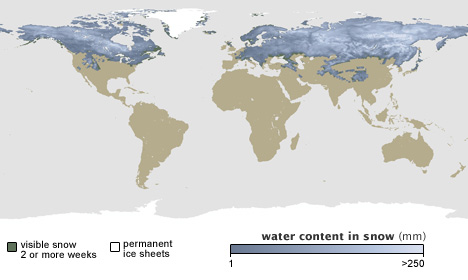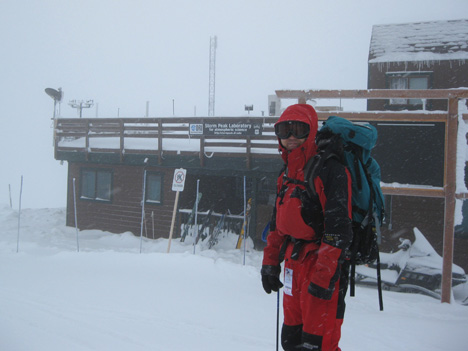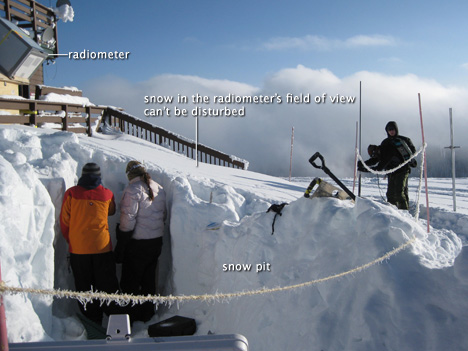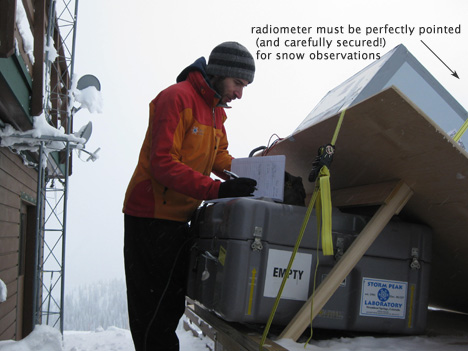

Last night, we took load #1 of equipment down the mountain. Today was dedicated to packing up & hauling the rest of the equipment down with the snowcat. A bit of a snowstorm is in the forecast, and we need to get our equipment down before it hits. Sound familiar? Friday, a truck will take the radiometer home to NASA Goddard…to be prepared for its next adventure.
Here is a closing photo of a sun pillar we saw a few days ago.

Today is our last day of measurements. We took a radiometer measurement in the morning, and then dug the final snowpit in the exact spot that the radiometer was viewing during the whole experiment. That way, we will know exactly what the radiometer was seeing. The pit measurements took hours and it was cold today with the wind blowing. Ty spent nearly the entire day in the pit. Volunteer Michael Harvey, MD, helped. Still it took until sundown. The data appear to be OK for the whole experiment. What a huge relief!
Last week, our primary instrument (the radiometer) arrived barely in time & wasn’t even complete because of the big Washington DC snowstorm. But after many days of hard work by the whole experiment team & our great Storm Peak Lab hosts, we managed to get our measurements.
Snow measurements by satellite radiometers are the key to estimating how much water is held by snow across the globe.

The radiometer we used in this experiment makes measurements the same way as radiometers on satellites such as the AMSR-E radiometer on the Aqua satellite. But since we are observing a much smaller area in this experiment than the space-based radiometers view (meters instead of kilometers), we have much less variability to deal with, *and* we took detailed measurements of the actual snow characteristics.
That means we should be able to develop a more accurate relationship between what a radiometer sees and the true snow water content. A more accurate relationship is what we need to improve satellite snow observations, and the most direct way to find that relationship is by doing a carefully-controlled field experiment…only it takes a lot of hard work by teams of scientists, engineers, and technicians to do one…plus a little luck. So many things have to come together, especially when the weather doesn’t fully cooperate.
Here is how we “commute'” to the lab each morning.

Dr. Noah Molotch (U. Colorado), Dr. Dan Berisford (JPL) Jen Petrzelka (U. Colorado), and Ty Atkins spent all day today (and the previous 2 days) making snowpit measurements using both traditional and new high-tech methods. In this photo, you can see how deep the snowpit is.

We’ll be comparing the snowpit measurements with the radiometer measurements. Right now, we have to be very careful not to disturb the snow that the radiometer is looking at, so the pit is off to one side.
A big milestone today: after the DC snowstorm, the cross-country shipping, the snowcat trip up the mountain, and the days of wiring, we finally got radiometer data today. Dr. Mike Durand and Ty Atkins (U. Colorado) worked really hard to set up a stand built by Goddard engineers to hold the radiometer at just the right angle…without sliding off into the snow. We don’ t want the radiometer to get any ideas just because the Olympics are going on.
